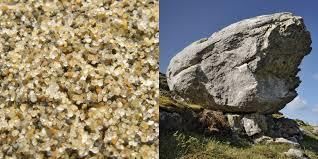Year 3 Exam > Year 3 Notes > Year 3 Science > Types of rock
Types of rock | Year 3 Science PDF Download
Rocks
There are many types of rocks, each with unique properties and uses. Some are strong and hard, while others are soft and sandy.

Properties and uses: Soft and hard rock
- Some rocks are more durable than others. For instance, granite is exceptionally hard, making it an excellent choice for construction due to its resistance to erosion.
- Marble, also a hard rock, is prized for its appealing texture and color. It can be finely cut and polished, which makes it ideal for creating floor and wall tiles, as well as sculptures.
- Chalk, on the other hand, is a soft rock that erodes easily. This characteristic makes it well-suited for producing chalk sticks used for writing on blackboards.
Properties and uses: permeable and impermeable rock
- Some rocks, like sandstone or chalk, allow water to pass through them, which classifies them as permeable rocks.
- In contrast, impermeable rocks such as slate do not allow water to penetrate. Slate is also known for its ability to split into thin sheets easily, making it a preferred material for manufacturing roof tiles.
Question for Types of rockTry yourself: Which type of rock is best suited for constructing roof tiles due to its impermeable nature?View Solution
The document Types of rock | Year 3 Science is a part of the Year 3 Course Year 3 Science.
All you need of Year 3 at this link: Year 3
|
20 videos|23 docs|5 tests
|
FAQs on Types of rock - Year 3 Science
| 1. What are the three main types of rocks? |  |
Ans. The three main types of rocks are igneous, sedimentary, and metamorphic rocks.
| 2. How are igneous rocks formed? |  |
Ans. Igneous rocks are formed from the cooling and solidification of magma or lava.
| 3. What is the difference between sedimentary and metamorphic rocks? |  |
Ans. Sedimentary rocks are formed from the accumulation and cementation of sediments, while metamorphic rocks are formed from the alteration of existing rocks through heat and pressure.
| 4. How can you identify different types of rocks? |  |
Ans. Rocks can be identified based on their physical characteristics such as color, texture, and mineral composition.
| 5. What are some common examples of each type of rock? |  |
Ans. Some common examples of igneous rocks are granite and basalt, sedimentary rocks include limestone and sandstone, and metamorphic rocks include marble and slate.
Related Searches




















